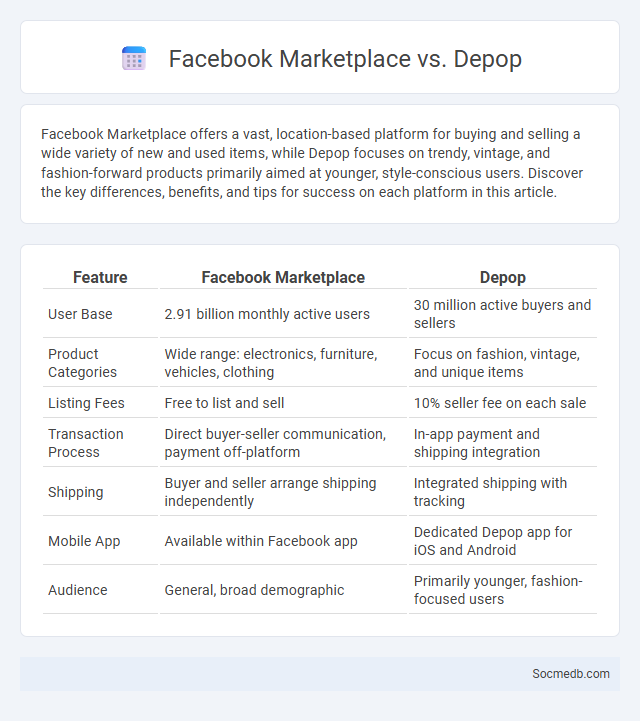
Photo illustration: Facebook Marketplace vs Depop
Facebook Marketplace offers a vast, location-based platform for buying and selling a wide variety of new and used items, while Depop focuses on trendy, vintage, and fashion-forward products primarily aimed at younger, style-conscious users. Discover the key differences, benefits, and tips for success on each platform in this article.
Table of Comparison
| Feature | Facebook Marketplace | Depop |
|---|---|---|
| User Base | 2.91 billion monthly active users | 30 million active buyers and sellers |
| Product Categories | Wide range: electronics, furniture, vehicles, clothing | Focus on fashion, vintage, and unique items |
| Listing Fees | Free to list and sell | 10% seller fee on each sale |
| Transaction Process | Direct buyer-seller communication, payment off-platform | In-app payment and shipping integration |
| Shipping | Buyer and seller arrange shipping independently | Integrated shipping with tracking |
| Mobile App | Available within Facebook app | Dedicated Depop app for iOS and Android |
| Audience | General, broad demographic | Primarily younger, fashion-focused users |
Overview: Facebook Marketplace, Depop, and Marketplace Compared
Facebook Marketplace offers a vast user base and seamless integration with existing Facebook profiles, enabling local buying and selling of a wide range of goods. Depop caters to a younger audience with a focus on unique, vintage, and fashion items, leveraging social media-style engagement and personalized storefronts. Comparing both platforms, Facebook Marketplace excels in broad accessibility and variety, while Depop stands out for niche markets and community-driven interaction, making each suitable for different seller and buyer preferences.
User Demographics: Who Shops Where?
User demographics reveal distinct shopping behaviors across social media platforms, with Instagram attracting younger audiences aged 18-29 who favor fashion and beauty products, while Facebook's broader age range engages more with household goods and electronics. Pinterest users, predominantly female and aged 25-45, frequently shop for home decor and DIY supplies, providing brands targeted opportunities to reach niche markets. Understanding these demographic trends helps you tailor marketing strategies, ensuring your products appear on the platforms where your ideal customers actively shop.
Product Categories and Listings
Product categories and listings on social media are essential for organizing and showcasing your inventory, enhancing customer navigation and discovery. Optimized product listings include detailed descriptions, high-quality images, accurate pricing, and relevant tags to improve visibility in platform search algorithms. Utilizing social media's shopping features boosts engagement, drives traffic to your online store, and increases conversion rates through seamless purchasing experiences.
Pricing Strategies and Fees
Social media platforms implement diverse pricing strategies including freemium models, subscription plans, and ad-based monetization to maximize revenue and user engagement. Advertising fees vary significantly, often determined by cost-per-click (CPC), cost-per-impression (CPM), or cost-per-action (CPA) metrics tailored to campaign objectives. Premium features and influencer partnerships also contribute to revenue through tiered pricing and commission structures optimized for market demand.
Ease of Use and User Experience
Social media platforms are designed with intuitive interfaces to enhance ease of use, allowing users to navigate effortlessly and engage with content seamlessly. Personalized features such as customizable profiles, interactive notifications, and streamlined posting tools significantly improve your user experience by making interactions more efficient and enjoyable. Continuous updates and user feedback integration further optimize usability, ensuring that social media remains accessible and user-friendly across devices.
Location and Shipping Options
Social media platforms offer advanced location tagging features that enhance user engagement and targeted marketing, allowing businesses to tailor content and promotions based on geographic preferences. Your shipping options can be optimized by integrating location data from social media insights, improving delivery efficiency and customer satisfaction. Leveraging these tools helps streamline operations and increases the precision of marketing strategies.
Security and Buyer Protection
Social media platforms implement advanced encryption and multi-factor authentication to enhance your account security and safeguard personal information from cyber threats. Buyer protection policies such as secure payment gateways, verified seller badges, and dispute resolution systems help ensure safe transactions and prevent fraud. Understanding these security measures empowers you to confidently engage in social media commerce with greater protection.
Social Features and Community Engagement
Social features such as interactive polls, live chats, and user-generated content drive higher community engagement by fostering authentic connections among users. Platforms with robust social features encourage Your active participation, enabling you to share experiences, collaborate, and build meaningful relationships. Enhanced community engagement boosts brand loyalty and amplifies the reach of your social media presence through organic interactions.
Selling Process and Tools
Effective selling on social media leverages platforms like Instagram, Facebook, and LinkedIn to engage potential customers with targeted ads and personalized content. Your sales process can be streamlined using tools such as CRM integrations, chatbots for instant communication, and analytics software to track customer behavior and optimize conversions. Incorporating these tools enhances lead generation, nurtures relationships, and accelerates the buying journey directly within social media ecosystems.
Which Platform Wins: Key Pros and Cons
Choosing the right social media platform depends on your goals and audience, as each offers unique advantages and limitations. Instagram excels in visual storytelling and influencer marketing, while LinkedIn is ideal for B2B networking and professional growth, with Facebook providing robust community engagement tools. You should consider factors like audience demographics, content type, and analytics capabilities to determine which platform aligns best with your strategy.
 socmedb.com
socmedb.com